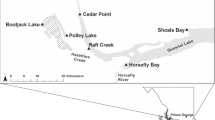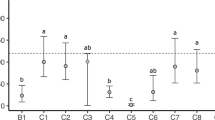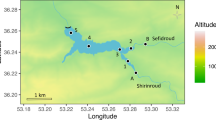Abstract
Permanent reclamation of tailings generated by surface mining in the Canadian oil sands may be achieved through the creation of end pit lakes (EPLs) in which tailings are stored in mined-out pits and capped with water. However, these tailings contain high concentrations of dissolved organics, metals, and salts, and thus surface water quality of EPLs is a significant concern. This is the first study to investigate the chronic toxicity of surface water from Base Mine Lake (BML), the Canadian oil sands first large-scale EPL, to aquatic invertebrates that play a vital role in the early development of aquatic ecosystems (Chironomus dilutus and Ceriodaphnia dubia). After exposure of C. dilutus larvae for 23 days and C. dubia neonates for 8 days, no mortality was observed in any treatment with whole BML surface water. However, the emergence of C. dilutus adults was delayed by nearly 1 week, and their survival was significantly reduced (36%) compared with the controls. Reproduction (fecundity) of C. dubia was reduced by 20% after exposure to 2014 BML surface water; however, the effect was not observed after exposure to BML surface water collected a year later in 2015. Despite some adverse effects, the results of this study indicate that BML surface water quality is improving over time and is able to support certain salt-tolerant aquatic organisms. Because salinity within BML will persist for decades without manual intervention, the ecological development of the lake will likely resemble that of a brackish or estuarine ecosystem with reduced diversity.



Similar content being viewed by others
References
AEP (2015a) Mineable oil sands fluid tailings volume by facility as of the end of 2013. Oil Sands Information Portal, Alberta Environment and Parks, Edmonton, AB. Dataset no. 540. http://osip.alberta.ca/library/Dataset/Details/540. Accessed 27 Feb 2015
AEP (2015b) Total area of the oil sands tailings ponds over time. Oil Sands Information Portal, Alberta Environment and Parks, Edmonton, AB. Dataset no. 542. http://osip.alberta.ca/library/Dataset/Details/542. Accessed 4 Mar 2015
Aladin NV (1991) Salinity tolerance and morphology of the osmoregulation organs in Cladocera with special reference to Cladocera from the Aral Sea. Hydrobiologia 225:291–299
Aladin NV, Potts WTW (1995) Osmoregulatory capacity of the Cladocera. J Comp Physiol B 164:671–683
Alharbi HA, Morandi G, Giesy JP, Wiseman SB (2016a) Effect of oil sands process-affected water on toxicity of retene to early life-stages of Japanese medaka (Oryzias latipes). Aquat Toxicol 176:1–9
Alharbi HA, Saunders DVM, Al-Mousa A, Alcorn J, Pereira AS, Martin JW, Giesy JP, Wiseman SB (2016b) Inhibition of ABC transport proteins by oil sands process affected water. Aquat Toxicol 170:81–88
Anderson JC, Wiseman SB, Wang N, Moustafa A, Perez-Estrada L, Gamal El-Din M, Martin JW, Liber K, Giesy JP (2012a) Effectiveness of ozonation treatment in eliminating toxicity of oil sands process-affected water to Chironomus dilutus. Environ Sci Technol 46:486–493
Anderson JC, Wiseman SB, Moustafa A, Gamal El-Din M, Liber K, Giesy JP (2012b) Effects of exposure to oil sands process-affected water from experimental reclamation ponds on Chironomus dilutus. Water Res 46:1662–1672
Arriaga D, Nelson TC, Risacher FF, Morris PK, Goad C, Slater GF, Warren LA (2019) The co-importance of physical mixing and biogeochemical consumption in controlling water cap oxygen levels in Base Mine Lake. Appl Geochem 111:104442
Baker JA, Gilron G, Chalmers BA, Elphick JR (2017) Evaluation of the effect of water type on the toxicity of nitrate to aquatic organisms. Chemosphere 168:435–440
Bartlett AJ, Frank RA, Gillis PL, Parrott JL, Marentette JR, Brown LR, Hooey T, Vanderveen R, McInnis R, Brunswick P, Shang D, Headley JV, Peru KM, Hewitt LM (2017) Toxicity of naphthenic acids to invertebrates: extracts from oil sands process-affected water versus commercial mixtures. Environ Pollut 227:271–279
Bauer AE, Frank RA, Headley JV, Peru KM, Farwell AJ, Dixon DG (2017) Toxicity of oil sands acid-extractable organic fractions to freshwater fish: Pimephales promelas (fathead minnow) and Oryzias latipes (Japanese medaka). Chemosphere 171:168–176
Bauer AE, Hewitt LM, Parrott JL, Bartlett AJ, Gillis PL, Deeth LE, Rudy MD, Vanderveen R, Brown L, Campbell SD, Rodrigues MR, Farwell AJ, Dixon DG, Frank RA (2019) The toxicity of organic fractions from aged oil sands process-affected water to aquatic species. Sci Total Environ 669:702–710
Environment Canada (1997) Biological test method: test for survival and growth in sediment using the larvae of freshwater midges (Chironomus tentans or Chironomus riparius). Method Development and Applications Section, Environment Canada, Ottawa, ON
Environment Canada (2007) Biological test method: test of reproduction and survival using the cladoceran Ceriodaphnia dubia. Method Development and Applications Section, Environment Canada, Ottawa, ON
Clemente JS, Fedorak PM (2005) A review of the occurrence, analyses, toxicity, and biodegradation of naphthenic acids. Chemosphere 60:585–600
Dompierre KA, Lindsay MBJ, Cruz-Hernandez P, Halferdahl GM (2016) Initial geochemical characteristics of fluid fine tailings in an oil sands end pit lake. Sci Total Environ 556:196–206
Dompierre KA, Barbour SL, North RL, Carey SK, Lindsay MBJ (2017) Chemical mass transport between fluid fine tailings and the overlying water cover of an oil sands end pit lake. Water Resour Res 53:4725–4740
Elphick JRF, Bergh KD, Bailey HC (2011) Chronic toxicity of chloride to freshwater species: effects of hardness and implications of water quality guidelines. Environ Toxicol Chem 30:239–246
Erickson RJ, Mount DR, Highland TL, Hockett JR, Hoff DJ, Jenson CT, Norberg-King TJ, Peterson KN (2017) The acute toxicity of major ion salts to Ceriodaphnia dubia. II. Empirical relationships in binary salt mixtures. Environ Toxicol Chem 36:1525–1537
Erickson RJ, Mount DR, Highland TL, Hockett JR, Hoff DJ, Jenson CT, Norberg-King TJ, Peterson KN (2018) The acute toxicity of major ion salts to Ceriodaphnia dubia. III. Mathematical models for mixture toxicity. Environ Toxicol Chem 37:247–259
Farag AM, Harper DD (2014) The chronic toxicity of sodium bicarbonate, a major component of coal bed natural gas produced waters. Environ Toxicol Chem 33:532–540
Frank RA, Kavanagh R, Burnison BK, Arsenault G, Headley JV, Peru KM, Solomon KR (2008) Toxicity assessment of collected fractions from an extracted naphthenic acid mixture. Chemosphere 72:1309–1314
Freitas EC, Rocha O (2011) Acute and chronic effects of sodium and potassium on the tropical freshwater cladoceran Pseudosida ramosa. Ecotox 20:88–96
Gauss JD, Woods PE, Winner RW, Skillings JH (1985) Acute toxicity of copper to three life stages of Chironomus tentans as affected by water hardness/alkalinity. Environ Pollut 37:149–157
Harper DD, Farag AM, Skaar D (2014) Acute toxicity of sodium bicarbonate, a major component of coal bed natural gas produced waters, to 13 aquatic species as defined in the laboratory. Environ Toxicol Chem 33:525–531
He Y, Wiseman SB, Zhang X, Hecker M, Jones PD, Gamal El-Din M, Martin JW, Giesy JP (2010) Ozonation attenuates the steroidogenic disruptive effects of sediment free oil sands process water in the H295R cell line. Chemosphere 80:578–584
He Y, Wiseman SB, Hecker M, Zhang X, Wang N, Perez LA, Jones PD, Gamal El-Din M, Martin JW, Giesy JP (2011) Effect of ozonation on the estrogenicity and androgenicity of oil sands process-affected water. Environ Sci Technol 45:6268–6274
He Y, Patterson S, Wang N, Hecker M, Martin JW, Gamal El-Din M, Giesy JP, Wiseman SB (2012a) Toxicity of untreated and ozone-treated oil sands process-affected water (OSPW) to early life stages of the fathead minnow (Pimephales promelas). Water Res 46:6359–6368
He Y, Wiseman SB, Wang N, Perez-Estrada LA, Gamal El-Din M, Martin JW, Giesy JP (2012b) Transcriptional responses of the brain-gonad-liver axis of fathead minnows exposed to untreated and ozone-treated oil sands process-affected water. Environ Sci Technol 46:9701–9708
Hoke RA, Gala WR, Drake JB, Giesy JP (1992) Bicarbonate as a potential confounding factor in Cladoceran toxicity assessments of pore water from contaminated sediments. Can J Fish Aquat Sci 49:1633–1640
Kavanagh RJ, Frank RA, Oakes KD, Servos MR, Young RF, Fedorak PM, MacKinnon MD, Solomon KR, Dixon DG, van der Kraak G (2011) Fathead minnow (Pimephales promelas) reproduction is impaired in aged oil sands process-affected waters. Aquat Toxicol 101:214–220
Kavanagh RJ, Frank RA, Burnison BK, Young RF, Fedorak PM, Solomon KR, Van Der Kraak G (2012) Fathead minnow (Pimephales promelas) reproduction is impaired when exposed to a naphthenic acid extract. Aquat Toxicol 116–117:34–42
Kennedy KD (2012) Growth, survival, and community composition of Chironomidae (Diptera) larvae in selected Athabasca oil sands process-affected wetlands waters of north-eastern Alberta. M.Sc. Dissertation, Department of Biological Sciences, University of Windsor, Windsor, ON, Canada. https://scholar.uwindsor.ca/etd/4820/. Accessed 21 Apr 2017
Lari E, Steinkey D, Mohaddes E, Pyle GG (2017) Investigating the chronic effects of oil sands process-affected water on growth and fitness of Daphnia magna Straus 1820. Sci Total Environ 595:594–600
Lari E, Steinkey D, Pyle GG (2018) Effects of seasonal changes on the toxic impacts of oil sands process-affected water on Daphnia magna. Arch Environ Contam Toxicol 74:408–413
Lari E, Steinkey D, Razmara P, Mohaddes E, Pyle GG (2019) Oil sands process-affected water impairs the olfactory system of rainbow trout (Oncorhynchus mykiss). Ecotox Environ Saf 170:62–67
Lasier PJ, Hardin IR (2010) Observed and predicted reproduction of Ceriodaphnia dubia exposed to chloride, sulfate, and bicarbonate. Environ Toxicol Chem 29:347–358
Leclair LA, MacDonald GZ, Phalen LJ, Kollner B, Hogan NS, van den Heuvel MR (2013) The immunological effects of oil sands surface waters and naphthenic acids on rainbow trout (Oncorhynchus mykiss). Aquat Toxicol 142–143:185–194
Leonhardt CL (2003) Zoobenthic succession in constructed wetlands of the Fort McMurray oil sands region: developing a measure of zoobenthic recovery. M.Sc. dissertation. University of Windsor, Windsor, ON, Canada. https://scholar.uwindsor.ca/etd/4612. Accessed 21 Apr 2017
Liber K, Call DJ, Dawson TD, Whiteman FW, Dillon TM (1996) Effects of Chironomus tentans larval growth retardation on adult emergence and ovipositing success: implications for interpreting freshwater sediment bioassays. Hydrobiologia 323:155–167
Lyons DD, Philibert DA, Zablocki T, Qin R, Huang R, Gamal El-Din M, Tierney KB (2018) Assessment of raw and ozonated oil sands process-affected water exposure in developing zebrafish: associating morphological changes with gene expression. Environ Pollut 241:959–968
MacDonald GZ, Hogan NS, Kollner B, Thorpe KL, Phalen LJ, Wagner BD, van den Heuvel MR (2013) Immunotoxic effects of oil sands-derived naphthenic acids to rainbow trout. Aquat Toxicol 126:95–103
McNeill SA, Arens CJ, Hogan NS, Kollner B, van den Heuvel MR (2012) Immunological impacts of oil sands-affected waters on rainbow trout evaluated using an in situ exposure. Ecotoxicol Environ Saf 84:254–261
McQueen AD, Kinley CM, Hendrikse M, Gaspari DP, Calomeni AJ, Iwinski KJ, Castle JW, Haakensen MC, Peru KM, Headley JV, Rodgers JH (2017) A risk-based approach for identifying constituents of concern in oil sands process-affected water from the Athabasca Oil Sands region. Chemosphere 173:340–350
Morandi GD, Wiseman SB, Pereira A, Mankidy R, Gault IGM, Martin JW, Giesy JP (2015) Effects-directed analysis of dissolved organic compounds in oil sands process-affected water. Envrion Sci Technol 49:12395–12404
Morandi GD, Zhang K, Wiseman SB, Pereira A, Martin JW, Giesy JP (2016) Effect of lipid partitioning on predictions of acute toxicity of oil sands process affected water to embryos of fathead minnow (Pimephales promelas). Environ Sci Technol 50:8858–8866
Mori JF, Chen LX, Jessen GL, Rudderham SB, McBeth JM, Lindsay MBJ, Slater GF, Banfield JF, Warren LA (2019) Putative mixotrophic nitrifying-denitrifying gammaproteobacteria implicated in nitrogen cycling within the ammonia/oxygen transition zone of an oil sands pit lake. Front Microbiol 10:1–15
Mount DR, Erickson RJ, Highland TL, Hockett JR, Hoff DJ, Jenson CT, Norberg-King TJ, Peterson KN, Polaske ZM (2016) The acute toxicity of major ion salts to Ceriodaphnia dubia: I. influence of background water chemistry. Environ Toxicol Chem 35:3039–3057
Mount DR, Erickson RJ, Forsman BB, Highland TL, Hockett JR, Hoff DL, Jenson CT, Norberg-King TJ (2019) Chronic toxicity of major ion salts and their mixtures to Ceriodaphnia dubia. Environ Toxicol Chem 38:769–783
Naddy RB, La Point TW, Klaine SJ (1995) Toxicity of arsenic, molybdenum and selenium combinations to Ceriodaphnia dubia. Environ Toxicol Chem 14:329–336
Pourrezai P, Drzewicz P, Wang Y, Gamal El-Din M, Perez-Estrada LA, Martin JW, Anderson J, Wiseman S, Liber K, Giesy JP (2011) The impact of metallic coagulants on the removal of organic compounds from oil sands process-affect water. Environ Sci Technol 45:8452–8459
Richardson E, Bass D, Smirnova A, Paoli L, Dunfield P, Dacks JB (2020) Phylogenetic estimation of community composition and novel eukaryotic lineages in base mine lake: an oil sands tailings reclamation site in Northern Alberta. J Eukaryot Microbiol 67:86–99. https://doi.org/10.1111/jeu.12757
Risacher FF, Morris PK, Arriaga D, Goad C, Nelson TC, Slater GF, Warren LA (2018) The interplay of methane and ammonia as key oxygen consuming constituents in early stage development of Base Mine Lake, the first demonstration oil sands pit lake. Appl Geochem 93:49–59
Schramm LL, Smith RG (1985) The influence of natural surfactants on interfacial charges in the hot-water process for recovering bitumen from the Athabasca oil sands. Colloid Surf 14:61–85
Sibley PK, Benoit DA, Ankley GT (1997) The significance of growth in Chironomus tentans sediment toxicity tests: relationship to reproduction and demographic endpoints. Environ Toxicol Chem 16:336–345
Simmons JA (2012) Toxicity of major cations and anions (Na+, K+, Ca2+, Mg2+, Cl− and SO42−) to a macrophyte and an alga. Environ Toxicol Chem 31:1370–1374
Soucek DJ (2007) Bioenergetic effects of sodium sulfate on the freshwater crustacean, Ceriodaphnia dubia. Ecotox 16:317–325
Soucek DJ, Dickinson A (2016) Influence of chloride on the chronic toxicity of sodium nitrate to Ceriodaphnia dubia and Hyalella azteca. Ecotox 25:1406–1416
Sun J, Peng H, Alharbi HA, Jones PD, Giesy JP (2017) Identification of chemicals that cause oxidative stress in oil sands process-affected water. Environ Sci Technol 51:8773–8781
Tedford E, Halferdahl G, Pieters R, Lawrence GA (2019) Temporal variations in turbidity in an oil sands pit lake. Environ Fluid Mech 19:457–473
Toor NS, Franz ED, Fedorak PM, MacKinnon MD, Liber K (2013a) Degradation and aquatic toxicity of naphthenic acids in oil sands process-affected waters using simulated wetlands. Chemosphere 90:449–458
Toor NS, Han X, Franz E, MacKinnon MD, Martin JW, Liber K (2013b) Selective biodegradation of naphthenic acids and a probable link between mixture profiles and aquatic toxicity. Environ Toxicol Chem 32:2207–2216
Turcotte D, Kautzman M, Peru K, Headley J, Liber K (2009) Characterizing salt and naphthenic acids interaction in the toxicity of oil sands process water to freshwater invertebrates. Conference presentation, University of Saskatchewan, unpublished pilot study
van den Heuvel MR, Hogan NS, Roloson SD, van der Kraak GJ (2012) Reproductive development of yellow perch (Perca flavescens) exposed to oil sands-affected waters. Environ Toxicol Chem 31:654–662
Vera CL, Hyne RV, Patra R, Ramasamy S, Pablo F, Julli M, Kefford BJ (2014) Bicarbonate toxicity to Ceriodaphnia dubia and the freshwater shrimp Paratya australiensis and its influence on zinc toxicity. Environ Toxicol Chem 33:1179–1186
Whelly MP (2000) Aquatic invertebrates in wetlands of the oil sands region of northeast Alberta, Canada, with emphasis on Chironomidae (Diptera). M.Sc. Dissertation. University of Windsor, Windsor, ON, Canada. https://scholar.uwindsor.ca/etd/1207. Accessed 21 Apr 2017
White KB, Liber K (2018) Early chemical and toxicological risk characterization of inorganic constituents in surface water from the Canadian oil sands first large-scale end pit lake. Chemosphere 211:745–757
Wiseman SB, Anderson JC, Liber K, Giesy JP (2013a) Endocrine disruption and oxidative stress in larvae of Chironomus dilutus following short-term exposure to fresh or aged oil sands process-affected water. Aquat Toxicol 142–143:414–421
Wiseman SB, He Y, Gamal-El Din M, Martin JW, Jones PD, Hecker M, Giesy JP (2013b) Transcriptional responses of male fathead minnows exposed to oil sands process-affected water. Comp Biochem Physiol C 157:227–235
Acknowledgements
This research was funded by the University of Saskatchewan Toxicology Centre and the Toxicology Graduate Program. The authors thank Stephanie Schiffer, Katherine Raes, and Erin Maloney for their assistance in the culturing and care of test organisms used in this study.
Author information
Authors and Affiliations
Corresponding author
Electronic supplementary material
Below is the link to the electronic supplementary material.
Rights and permissions
About this article
Cite this article
White, K.B., Liber, K. Chronic Toxicity of Surface Water from a Canadian Oil Sands End Pit Lake to the Freshwater Invertebrates Chironomus dilutus and Ceriodaphnia dubia. Arch Environ Contam Toxicol 78, 439–450 (2020). https://doi.org/10.1007/s00244-020-00720-3
Received:
Accepted:
Published:
Issue Date:
DOI: https://doi.org/10.1007/s00244-020-00720-3




